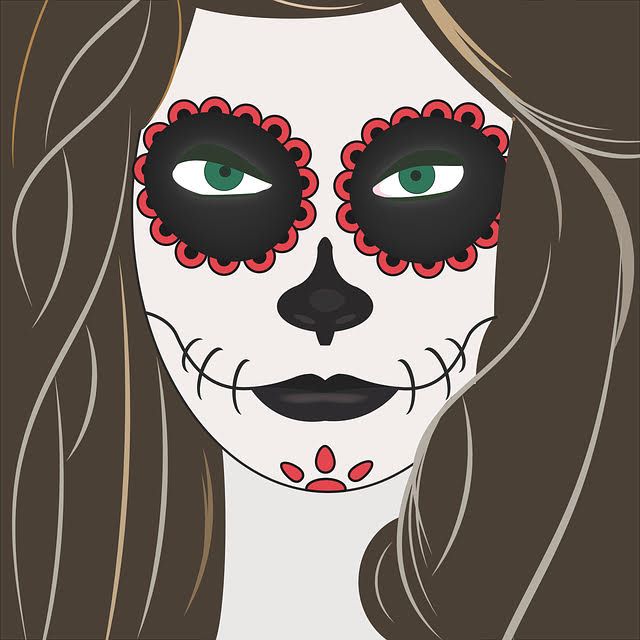By TR Robertson
The Day of the Dead (el Dia de los Muertos) is a traditional Mexican holiday celebrated on November 1st and 2nd. The holiday is mostly observed in Mexico, but is celebrated in other countries as well, especially by people of Mexican heritage. It is associated with the Catholic celebrations of All Saints’ Day and All Souls’ Day but has more of a joyful celebration rather than days of mourning. The Day of the Dead celebrations welcome and honor deceased relatives with food, drink, and festivities.
This traditional Mesoamerican ritual combines European religion and Spanish culture, celebrated each year from October 31st to November 2nd. October 31st is Halloween, not part of the traditional holiday. November 1st is Dia de los Angelitos, Spirits of the Children, Day of the Little Angels. This day begins at midnight of November 1st, where spirits of all deceased children are believed to be reunited with their families for 24 hours. Families construct an altar, “Ofrendas,” where snacks, candies, toys, and photographs are displayed to encourage the spirits of their departed children to be with them. Names of the departed children are written on sugar skulls.
November 2nd, at midnight, the celebrations shift to honor the lives of departed adults. This night is filled with celebration and memories of the departed. The Ofrendas take on a more adult theme with tequila, pan de muerto, mezcal, pulque and jars of Atole given in honor of the deceased. Families will play games, tell stories and dance in their honor. At noon, the celebrations will then shift again, this time as a public celebration of Dia de los Muretos. People will come together, many dressed in Calavera painted faces (skeletons). Parades will begin throughout various cities, many concluding in cemeteries where graves of the deceased are decorated with Marigold flowers (cempasuchil), gifts and sugar skulls. Many times, the gravestones are cleaned, if needed, to honor the deceased.
The beginnings of the Day of the Dead celebrations go back some 3,000 years to rituals honoring the dead in pre-Columbian Mesoamerica. The Aztecs and other Nahua people, living in central Mexico, saw death as an integral part of life and celebration of the dead a way to honor them when they were alive. In traditional Nanua cultures, the celebrations took place in August, when food, water and gifts were given to assist the deceased as they passed through the afterlife, as their souls journeyed to reach Mictlan, a final resting place. This inspiration would eventually lead to the current Day of the Dead celebrations.
In ancient Europe, early pagan cultures would offer celebrations of the dead in the fall of the year, often involving bonfires, dancing, and feasting. As time passed, with the rise of organized religions in Europe, some of these early traditions were incorporated unofficially into the Roman Catholic Church and would appear as minor Catholic holidays, All Saints Day, and All Souls Day. In medieval Spain, people would bring wine and pan de animas (spirit bread) to the graves of the departed on All Souls Day, including covering the graves with flowers and candles. Today, in the Day of the Dead celebrations in Mexico, pan de muerto (sweet baked goods) are used. In the 16th century, Spanish conquistadors would bring many of these traditions with them as explorations expanded in the Americas. Other drinks added to the celebration in the New World was a spicy dark chocolate drink and a corn-based drink called Atole.
It should be noted that Day of the Dead celebrations are different from Halloween. The celebrations occur mostly in Mexico and some parts of Central and South America, becoming more popular in Latino cultures in the United States as well. It is also important to know that this is a celebration of life, not death. A chance to remember and celebrate the lives of departed loved ones. The Ofrenda (alter) is a temporary alter and a way to honor the deceased. It has become a recognized symbol of the Day of the Dead. Four elements are part of the alter: water, wind, earth, and fire. Pitchers of water are left for the deceased, Papel picade (paper banners) represent wind. Earth is represented by food, especially pan de muerto. Candles are often left in the form of a cross to represent the cardinal directions so the soul of the dead can find their way. The cempasucil, (Marigold flowers) are on the Ofrenda, their strong sent helping the soul of the deceased find the way from the cemetery to the alter. Monarch butterflies also appear on the alter, symbolizing their arrival in Mexico for the winter and brightly decorated skulls are part of the alter, not as a morbid symbol, but as a symbol of the cycle of life and death.
Hopefully, this will give you an understanding of this time-honored tradition and the celebrations that take place each year at this time. The more we understand, the more we respect the various cultural practices of those around us.



















